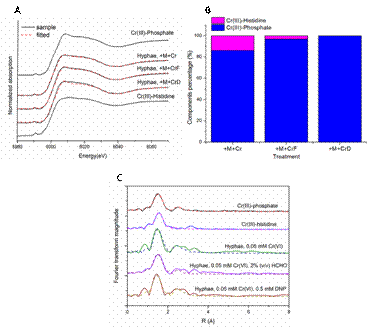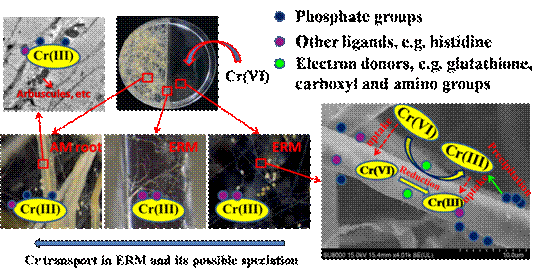| Chromium translocation and transformaton in the mycorrhizosphere |
| From: PublishDate:2016-06-03 Hits: |
Arbuscular mycorrhizal fungi (AMF) are ubiquitous soil fungi that form symbiotic relationships with more than 80% terrestrial plants. The fungi provide mineral nutrients (especially phosphorus) and water to their plant partner, and in return they get carbohydrates from the host plants. Additionally, AM symbiosis can significantly enhance plant survival under Cr contamination, and thus has a great potential in phytoremedation of soils contaminated with Cr. However, the detailed processes of Cr translocation and transformation in plant-AMF symbioses are unclear. Recently, a research group from Research Center for Eco-Environmental Sciences, Chinese Academy of Sciences, China has deeply investigated the processes of chromium translocation and transformaton in the plant-AM fungi continuum, and their results has been published on 15th, Dec, 2015 in Environmental Science & Technology. In their previous study, through using X-ray fluorescence micro-spectroscopy (μ-XRF) analysis, they found that Cr was mainly located in vascular bundle and cortex in the principal roots without AMF inoculation, while Cr was only located in cortex in principal roots when the plant was inoculated with AMF. This might indicate that AM symbiosis could derease Cr translocation from roots to shoots, and thus enhance Cr stabilization in roots. In the present study, a two-compartment root-organ cultivation system has been used to study the direct interaction between AM fungi and chromium. The results showed that AMF could actively take up and transport Cr [either in the form of Cr(VI) or Cr(III)] to roots but retain above 70% of the total Cr in the fungal biomass, which indicates the importance of AMF mycelium on Cr immobilization by mycorrhizal roots. Through X-ray absorption near edge fine structure spectroscopy (XANES) coupled with linear combination fitting (LCF) analysis, they further found that Cr(VI) in the AMF was reduced completely to Cr(III) and subsequently precipitated mainly by phosphate analogues (the proportion of Cr(III)-phosphate was 86%) (Figure 1). However, when the AMF mycelium was metabolic inhibited by 2%(v/v) formaldehyde or 0.5 mmol L-1 2,4-Dinitrophenol (DNP, a respiration inhibitor and an uncoupler of oxidative phosphorylation, which can cause dissipation of the proton motive force across membranes, thereby inhibiting active metal uptake by fungi), the mycelium still could adsorb large quantities of Cr mainly in the form of Cr(III)-phosphate analogues (the proportion is above 95%) on fungal surface. Besides, extended X-ray absorption fine structure (EXAFS) analysis also confirmed the existance of mainly phosphate complexed Cr(III) in AM fungi.
Figure 1. (A) Linear combination fitting (LCF) results of X-ray absorption near-edge spectroscopy (XANES) Cr K edge normalized spectra for the hyphae from the hyphal compartment of the different treatments. The treatment “+M+Cr” represents AMF inoculation in root compartment, and the hyphae was treated with 0.05 mmol L-1 Cr(VI) in hyphal compartment; the treatment “+M+CrF” represents AMF inoculation in root compartment, and the hyphae was treated with 0.05 mmol L-1 Cr(VI) after 24-h 2% (v/v) formaldehyde treatment in hyphal compartment; the treatment “+M+CrD” represents AMF inoculation in root compartment, and the hyphae was treated with 0.05 mmol L-1 Cr(VI) and 0.5 mmol L-1 DNP in hyphal compartment. (B) Results of fitting XANES spectra of hyphal samples from different treatments with a linear combination of the measured data sets of standard Cr compounds. (C) Cr K-edge extended X-ray absorption fine structure (EXAFS) spectra of Cr(III) standard compounds and hyphae of different treatments. The solid lines represent experimental data, dashed lines represent simulations. It is well known that one of the important role of AMF is to assist host plants in P acquisition. AMF mycelium can direct take up P from distance and transport it to plant partners. The present study indicates that those P may possibly complex (precipitate) Cr, and thus contributes to Cr stabilization. The study has uncovered the detailed processes of Cr translocation and transformation in AM symbioses, which can not only contributes to understanding the mechanisms of the positive role of AM symbiosis in plant Cr tolerance, but also provide important information for development of mycorrhizal based bioremediation techniques.
Figure 2. Cr translocation and transformation in arbuscular mycorrhizal symbioses. Article: Songlin Wu, Xin Zhang, Yuqing Sun, Zhaoxiang Wu, Tao Li, Yajun Hu, Dan Su, Jitao Lv, Gang Li, Zhensong Zhang, Lirong Zheng, Jing Zhang and Baodong Chen*, Transformation and immobilization of chromium by arbuscular mycorrhizal fungi as revealed by SEM-EDS, TEM-EDS and XAFS. Environmental Science & Technology, 2015, 49 (24): 14036-14047. |
|
|
| Chinese
- Beamline 1W1 of BSRF started to runoperate in the couplingparasitic mode of BEPCII
- Synthesis of High Performance Polymer Materials for Field Effect-Transistors
- Surfactant molecular aggregates in green solvents
- GIXRD has played an important role in the characterization of organic thin-film transistors
Copyright © 2011 - 2012 Beijing Synchrotron Radiation Facility



